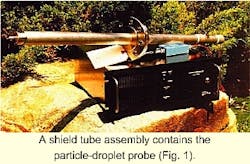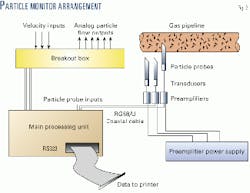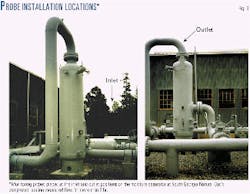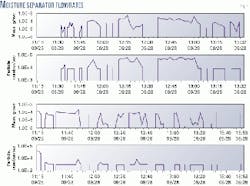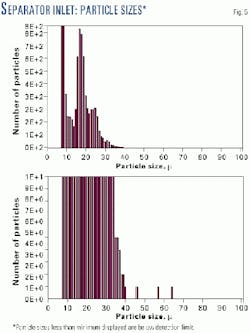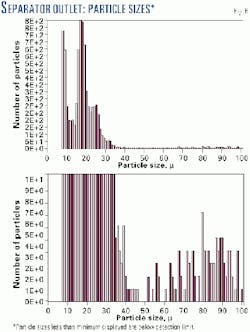Use of a new type of test that employs a continuous in-line, particle-droplet monitor1-3 has helped South Georgia Natural Gas Co., Birmingham, Ala., quantify the moisture content and size distribution of water droplets at one of its compressor stations.
Compressor stations are typically equipped with moisture separators and demisters to remove liquid water to improve gas quality and prevent corrosion and erosion.4 But this equipment may become overloaded and lead to high carry-over of water droplets.
In 1999, South Georgia Natural Gas hired Jonas Inc., Wilmington, Del., to determine the moisture content in the inlet and outlet streams of the compressor station's separator and, thereby, whether the separator was working properly.
This was the first time the particle-droplet monitor had been used for such an application.
Continuous monitoring
The particle-droplet monitor is a new instrument for continuous in-line monitoring of solid particle flow in gases and liquids, liquid droplets in gases, and solid particles-droplets in a space. It measures the number of particles or droplets per second and the mass flow rate and provides a histogram of particle-droplet size distribution.
The monitor is a multichannel acoustic emission instrument capable of detecting particle-droplet weights greater than 10-17 g (depending on the flow velocity) and particle-droplet impact rates on the detecting probe up to 20,000 particles/sec.
As many as eight locations can be monitored by one instrument. The accompanying box at the bottom of this page provides other characteristics of the monitor. The method is based on monitoring of minute shock waves produced by impacts of solid or liquid particles on a probe. A transducer converts these waves, which are proportional to the kinetic energy (KE) of the impacting particles-droplets, to an electrical signal, as the following equation shows:
KE = 1/2 mv2
where:
m = Mass
v = Impact velocity
Fig. 1 shows an example of the arrangement for monitoring of flow in a pipe; Fig. 2 provides a block diagram of the operation.
Each particle-droplet probe consists of a detecting probe installed in a shield tube assembly (Fig. 1). The tip of the detecting probe is inserted into the particle-droplet flow stream.
The monitor calculates the total particle-droplet mass flow in the pipe, based on the ratio of the pipe cross-sectional area to the detecting probe tip impact area. A transducer, which converts the particle-droplet impact vibrations into an electrical signal, is installed at the other end of the detecting probe.
The probe's signal from the transducer is locally amplified and sent to the monitor. If the particle-droplet velocity is constant, the velocity is programmed into the instrument; otherwise a velocity signal is provided to the instrument.
The monitor digitizes the particle-droplet flow signal for each impacting particle and processes it to calculate the particle-droplet flow rate, particle-droplet mass flow rate, and size distribution. All three values are stored in the monitor, and two analog outputs can output mass flow rate values.
As an option, the monitor can be setup to be accessible remotely through a modem or a network connection to download the stored data.
Test results
Separators at the end of South Georgia Natural Gas' 150-mile pipeline were removing up to 70 gal/month of water. To reduce the amount of moisture, a moisture separator was installed in early 1999 at a compressor station in eastern Alabama in the middle of the pipeline, upstream of the compressor.
After installation, however, the amount of moisture in the end user gas was unchanged. The assumption was that the new separator was not working correctly.
To verify this, South Georgia Natural Gas hired Jonas Inc. to determine the moisture content in the inlet and outlet streams of the separator. This was the first time the particle-droplet monitor had been used for this application.
On Sept. 28, 1999, Jonas installed particle-droplet monitor probes in the inlet and outlet piping of the separator through existing 0.5-in. vents (Fig. 3). During the approximately 2-hr test, the gas conditions were 60° F. and 975 psia and the flow velocity was 37.3 fps. The inlet and outlet streams were both monitored simultaneously for 2 hr.
The purpose of the test was to measure the quantity and size distribution of droplets in the inlet and outlet streams of the moisture separator to determine if it functions correctly.
The particle-droplet monitor determined that:
1. Under the test conditions, the measured mass flow of droplets through the separator was only 0.8 gal/year. This could be below the minimum amount of moisture at which the separator will work, resulting in the droplets continuing on to the compressor.
Fig. 4 shows the water droplet mass flow and number of droplets per second through the inlet and outlet piping over the duration of the test. The variable mass flow is typical of pipe wall wetting, collection of water in small pools, and periodic sloughing.
3. The small number of droplets present in the gas stream before the compressor cannot be responsible for the high amount of moisture (70 gal/month) removed at the pumping station 75 miles downstream.
Overall, the separator had little or no effect on the concentration of droplets at the conditions during the test. When the load is higher, there may be a higher concentration of droplets that will warrant use of the moisture separator.
The concentration of droplets should be measured to determine if the moisture separator is required. In future installations, the concentration of droplets should be determined before the moisture separator is installed.
Applications
As described here, this type of testing can be easily performed in only a few hours. In some instances, such as in this example, it could be determined that the moisture separator may be unnecessary, which can translate into substantial cost savings.
The monitor also has an application in oil and gas industries for monitoring sand and proppant in oil, and solid and liquid particles in gas.
In steam generation, the monitor has applications for detecting exfoliated oxides in steam lines; flue gas particulates for control of combustion, precipitators, bag filters, and emissions; coal pulverization; coal movement through hoppers; and the presence of water droplets in steam (water induction and carry-over).
It can also be used for environmental monitoring, detecting industrial emissions, dust and powders in the workplace, and fugitive dust.
Any industrial process in which the presence or flow of powders and fine or coarse particles needs to be monitored is a candidate application, including mixing, pigment and paint production, milling, and precipitation.
The monitor can also be used to detect the malfunction of particle-removal equipment such as filters.
References
- Jonas, O., "In-Line Monitoring of Particulates in Gas Streams," Final Report of SBIR Phase I Project, Jonas Inc. for the US Department of Energy, February 1987.
- Jonas, O., "New In-line, On-line Instrument for Monitoring of Particulates in Flue Gas," IJPGC 98, Baltimore, Aug. 23-26, 1998.
- Stockman, E.J., et al., "Measuring Steam Impurities in a Geothermal Pipe Line System using Real Time Instrumentation," Annual Meeting of the Geothermal Resources Council, San Francisco, Oct. 10-13, 1993.
- Dhulesia, H., and Lopez, D., "Critical Evaluation of Mechanistic Two-Phase Flow Pipeline and Well Simulation Models." SPE Annual Technical Conference, Denver, Oct. 6-9, 1996.
The authors
Otakar Jonas is president of Jonas Inc. He has more than 30 years of experience in water chemistry corrosion, instrumentation, research and development, and troubleshooting. He holds a PhD in power engineering from Czech Technical University, Prague.
Lee Machemer is an engineer at Jonas Inc. with 5 years of experience in water chemistry and corrosion, expert systems, and particlulate monitoring. He holds a bachelors in chemical engineering from the University of Delaware, Newark.


